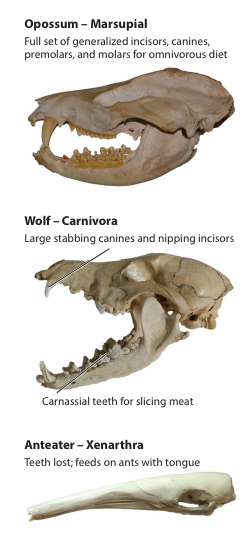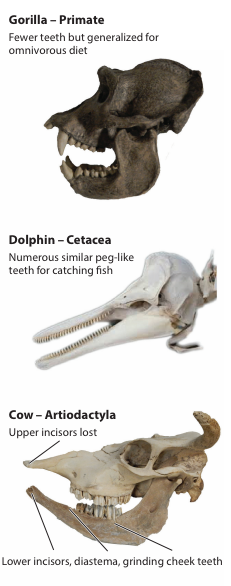The Princeton Field Guide to Prehistoric Mammals ,by Donald R. Prothero, is the first extinct animal book that you, dear reader, are going to give to someone for the holidays.
 This book is an interesting idea. Never mind the field guide part for a moment. This isn't really set up like a field guide, though it is produced by the excellent producers of excellent field guides at Princeton. But think about the core idea here. Take every group of mammal, typically at the level of Order (Mammal is class, there are more than two dozen living orders with about 5,000 species) and ask for each one, "what does the fossil record look like." In some cases, a very few living species are related to a huge diversity of extinct ones. In some cases, a highly diverse living fauna is related to a much smaller number of extinct ones. And each of these different relationships between the present and the past is a different and interesting evolutionary story.
This book is an interesting idea. Never mind the field guide part for a moment. This isn't really set up like a field guide, though it is produced by the excellent producers of excellent field guides at Princeton. But think about the core idea here. Take every group of mammal, typically at the level of Order (Mammal is class, there are more than two dozen living orders with about 5,000 species) and ask for each one, "what does the fossil record look like." In some cases, a very few living species are related to a huge diversity of extinct ones. In some cases, a highly diverse living fauna is related to a much smaller number of extinct ones. And each of these different relationships between the present and the past is a different and interesting evolutionary story.
If you looked only at the living mammals, you would miss a lot because there has been so much change in the past.
The giant sloths may be extinct, but Don Prothero himself is a giant of our age among fossil experts. His primary area of expertise includes the fossil mammals (especially but not at all limited to rhinos). I believe it is true that he has personally handled more fossil mammalian material, in terms of taxonomic breath and time depth, across more institutional collections, than anyone.
Don has written several different monographs on fossil mammal groups, and recently, a general fossil book for the masses, that have, I think added to his expertise on how to produce a book like this. Illustrations by Mary Persis Williams are excellent as well.
 A typical entry focuses on an order, and the orders are arranged in a taxonomically logical manner. A living or classic fossil representative is depicted, along with some boney material, in the form of drawings. Artist's reconstructions, photographs, maps, and other material, with phylogenetic charting where appropriate, fills out the overview of that order.
A typical entry focuses on an order, and the orders are arranged in a taxonomically logical manner. A living or classic fossil representative is depicted, along with some boney material, in the form of drawings. Artist's reconstructions, photographs, maps, and other material, with phylogenetic charting where appropriate, fills out the overview of that order.
The text is expert and informative, and very interesting. the quality of the presentation is to notch. The format of the book is large enough to let the artistry of the production emerge, but it is not a big too heavy floppy monster like some coffee table books are. This is a very comforatable book to sit and read, or browse.
It turns out that if you combine living and fossil forms for a given group, you get a much bigger picture of the facts underlying any one of a number of interesting evolutionary stories.
In addition to the order by order entries, front matter provides background to the science of paleontology, including phylogenetic method, taphonomy, etc. There is a bit of functional anatomy, and extra detailed material on teeth because, after all, the evolutionary history of man mammal groups is known primarily by analysis of (and discovery almost exclusively of) teeth.
The end matter includes a discussion of mammalian diversification, extinction, and an excellent index.
 If you wold like some background on how a scientist like Don Prothero writes a book like this, you can listen to this interview, in which we discuss this process in some detail.
If you wold like some background on how a scientist like Don Prothero writes a book like this, you can listen to this interview, in which we discuss this process in some detail.
One of the most important things about this book is that it is fully up to date, and thus, the only current mammalian evolutionary overview that is available, to my knowledge. In some areas of fossil mammal research (including in our own Order, Primates) there has been a lot of work over recent years, so this is important.
I highly recommend this excellent book.
The book as 240 pages, and 303 illustrations.
For your reference, I've pasted the TOC below.
Greg,
I just bought the book as a Christmas present for a young budding biologist. I hope it helps him reach his a great future.
Rich
I quite liked his book on Evolution and Fossils, and have both an e-copy and a paper copy for reading and rereading depending upon whether I'm traveling or sitting at home.
I also admire the effort he put into learning more about religious beliefs as too many science authors get it wrong. Some authors talking about Judaism or Christianity have as much credibility as Ken Ham or Kirk Cameron trying to talk about biology. Dr. Prothero took pains to not make those common errors derived from ignorance and arrogance.
This newest book looks good, and I have a young niece who would probably enjoy it (will have to buy myself a copy as well, of course).